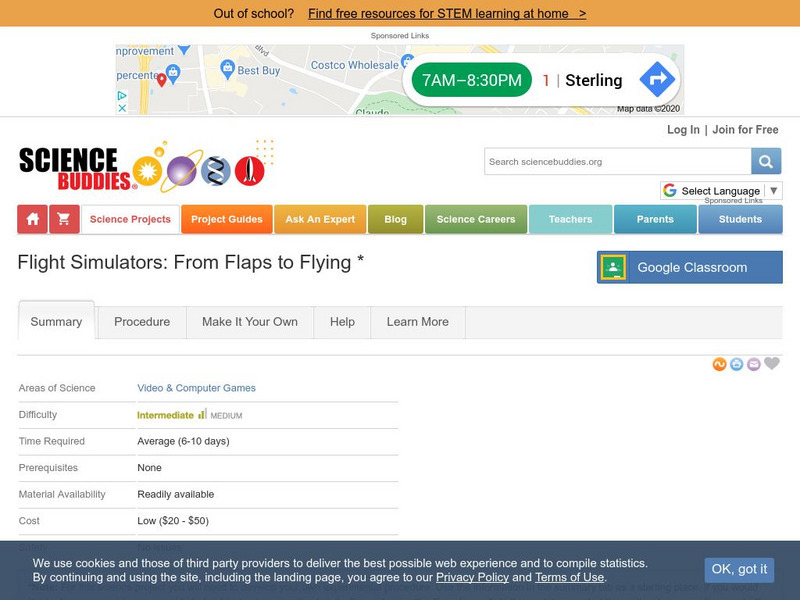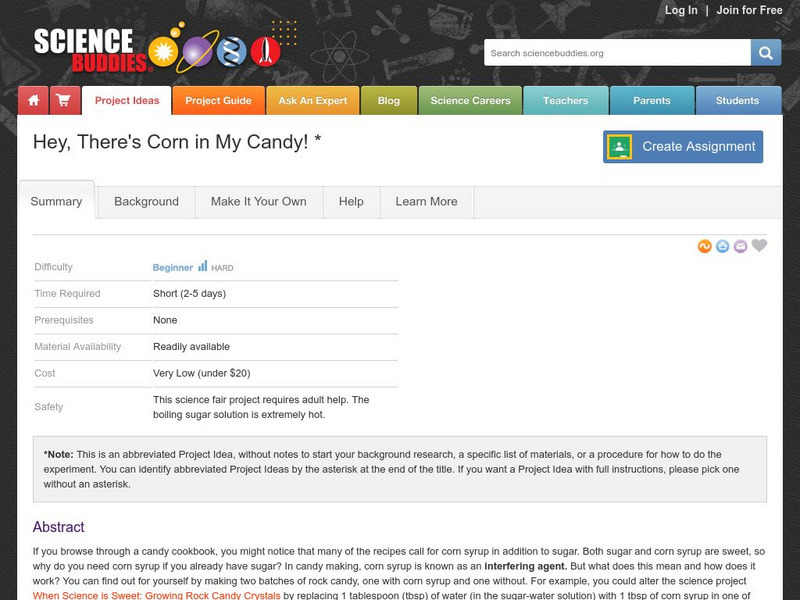Science Buddies
Science Buddies:from Your John to the School Lawn:is Recycled Water Really Safe?
Find out whether reclaimed water is really safe by following the guidelines of the Science Buddies project.
Science Buddies
Science Buddies:testing Compression Waves
Here's a project for studying compression waves in different soil types. It uses a homemade wave tank for solids, with a frequency generator, amplifier, and loudspeaker as the vibration source. There are lots of interesting possibilities...
Science Buddies
Science Buddies: Solubility of Proteins
Some proteins are soluble in aqueous solutions and some are not. Insoluble proteins can be a problem because the proteins can form large aggregates in solution which are difficult to purify, crystallize, and use in experiments. Compare...
Science Buddies
Science Buddies: Hey Gear Heads! The Physics of Bicycle Gear Ratios
Here's an abstract of a project from Science Buddies that asks you to experiment with bicycle gears and the circumference of the wheel to determine revolutions per minute.
Science Buddies
Science Buddies: Chain Reaction: Inversion and the Pappus Chain Theorem
Here is a challenging problem for anyone with an interest in geometry. This project requires background research to solve it, but it is an excellent illustration of visual thinking in mathematics.
Science Buddies
Science Buddies: Growing, Growing, Gone! An Experiment on Nitrogen Fertilizers
Plants need nitrogen to build proteins and nucleic acids to grow healthy stems and leaves. Though the Earth's atmosphere is made up of 79% nitrogen, the form of nitrogen found in the atmosphere cannot be used by plants. In this...
Science Buddies
Science Buddies: Measuring Speed of Moving Objects With Stroboscopic Photography
A strobe light can illuminate an entire room in just tens of microseconds. Inexpensive strobe lights can flash up to 10 or 20 times per second. This project shows you how to use stroboscopic photography to analyze motion.
Science Buddies
Science Buddies: Ozone Depletion
The ozone layer is important for blocking most of the harmful radiation that comes from the sun. You can find maps of the ozone layer and compare different regions of the globe for ozone coverage. Some scientists think that aerosols in...
Science Buddies
Science Buddies: Porosity
Soils are made of particles of different types and sizes. The space between particles is called pore space. Pore space determines the amount of water that a given volume of soil can hold. Porosity is the percentage of the total volume of...
Science Buddies
Science Buddies: Composting and Vermiculture
Make your own fertile soil using kitchen scraps, manure, leaves, grass clippings, and other compostable materials. Which materials make the best compost?
Science Buddies
Science Buddies: Measuring Velocity With a Video Camera
A video camera records 30 "frames" or distinct images per second. (That's for an NTSC camera in the U.S. PAL cameras in other areas of the world take 25 frames per second.) You can use this fact to time events and measure velocity. One...
Science Buddies
Science Buddies: Camera 'Shakes'
You can compare the picture quality for photos taken at different shutter speeds with the camera handheld vs. with the camera on a tripod. (This is best done with a camera that has manual exposure control.)
Science Buddies
Science Buddies: Digital Image Processing
Students who are mathematically inclined can use the student version of a program like MatLab or Mathematica to convert a digital image into numbers, then perform operations such as sharpening or special effects. This is a great way to...
Science Buddies
Science Buddies: Image Compression
Compare the strengths and weaknesses of different digital image formats. How does the amount of compression affect a JPEG image? What happens when you save a JPEG image multiple times?
Science Buddies
Science Buddies: Can Gaming Help You Score Better in School?
There are a variety of educational computer games on the market in the areas of math, history, science, and language, as well as many simpler versions free on the Internet. This exercise asks that you make up a test based on the subject...
Science Buddies
Science Buddies: Flight Simulators: From Flaps to Flying
Before pilots ever step behind the controls of a real jet they've already logged thousands of virtual air miles. It might not qualify you to fly a real jumbo jet, but you too, can learn the logistics of aviation by experimenting with the...
Science Buddies
Science Buddies: Fun or Frustrating?
Video games have different difficulty settings, from easy to hard mode. Ask volunteers who have never played the game before to try it out. Some of them should use the easy mode and others should use the hard mode, this will ensure that...
Science Buddies
Science Buddies: X Inactivation Marks the Spot for Cat Coat Color
A tortoiseshell cat has two different fur colors, black or brown and red or orange. The gene that gives rise to the red or orange fur color is on the X chromosome. Female cats have two X chromosomes, while males only have one, which...
Science Buddies
Science Buddies: Disinfectants
This experiment asks you to compare different types of cleaning agents. Household cleaning products, like bleach or Lysol, are included to see which ones kill the most bacteria. Different brands of antibacterial hand soap or dish soap...
Science Buddies
Science Buddies: Natural Antimicrobial Agents
This abstract asks you to discover what sources you can test for antimicrobial action by culturing bacteria in the presence of an extract from a source you hypothesize to have antimicrobial properties. Antimicrobial properties have been...
Science Buddies
Science Buddies: Cinnamon Gum and Mouth Microbes
A scientific study has shown that chewing Big Red Gum reduces mouth microbes. Cinnamon oil in gum is a natural defense against mouth bacteria that cause tooth decay and bad breath. Conduct an experiment to compare products with cinnamon...
Science Buddies
Science Buddies: Beats
Systematically explore different frequency combinations in this experiment provided by Science Buddies. You will use your computer to create sound files to play pure tones on your computer, one frequency in the left channel, and another...
Science Buddies
Science Buddies: Hey, There's Corn in My Candy!
In candy making, corn syrup is known as an "interfering agent." You can find out just what this agent does by making two batches of lollipops, one with corn syrup and one without and examining the differences between the two. Once you...
Science Buddies
Science Buddies: Candy Chromatography: What Makes Those Colors?
One of the characteristics that makes M&Ms so popular is dye that colors the hard shell, and of course the chocolate. But, many are unaware of what dyes are used to make those colors. This day long lab uses paper chromatography to...

























